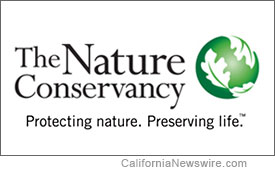 SAN FRANCISCO, Calif. /California Newswire/ — The Nature Conservancy released today their top ten Uniquely California Rivers list – those that have the highest number of freshwater plants and animals found nowhere else on earth. While the weather is nice, The Conservancy is encouraging people to grab their favorite outdoor gear and visit some of the most iconic and jaw-droppingly beautiful rivers that run through the Golden State.
SAN FRANCISCO, Calif. /California Newswire/ — The Nature Conservancy released today their top ten Uniquely California Rivers list – those that have the highest number of freshwater plants and animals found nowhere else on earth. While the weather is nice, The Conservancy is encouraging people to grab their favorite outdoor gear and visit some of the most iconic and jaw-droppingly beautiful rivers that run through the Golden State.
“With our mind-boggling variety of landscapes from deserts to redwood forests, in some regions like Central Coast, the Sacramento River and San Francisco Bay, nearly 50 percent of aquatic species found there are found nowhere else on earth,” said Jeanette Howard, Associate Director of Science, The Nature Conservancy.
The Nature Conservancy’s scientists undertook an analysis to identify those California rivers with the greatest number of endemics – species naturally occurring in one specific region only. After a diligent search, they discovered that no comprehensive aquatic species database for California exists, so they created a database of all known aquatic species and their locations.
The great news is that these same rivers are also some of California’s most spectacular vacation destinations to explore as summer winds down:
TUOLUMNE RIVER—Stanislaus, Tuolumne and Mariposa Counties
Designated a National Wild and Scenic River, the majestic Tuolumne begins at 13,000 feet in Yosemite National Park, winding through picture-perfect Tuolumne Meadows and providing world-class recreational opportunities from fishing to hiking for people of all ages and abilities.
What to look for: Yosemite toad (Anaxyrus canorus) and Dwarf downingia (Downingia pusilla)
Number of endemic species: 34
LOWER SACRAMENTO RIVER—Yolo, Sacramento and Solano Counties
Some say it’s the best fishing in the state; some say it’s the incomparable birding; while others vocally defend it as having the very best picnic spots. Winding its way south from Redding, the Lower Sacramento River winds through gentle river terraces, sheer canyon walls and rolling oak woodlands, providing something for everyone.
What to look for: Central Valley spring Chinook salmon (Oncorhynchus tshawytscha) and Valley arrowhead (Sagittaria sanfordii)
Number of endemic species: 33
SANTA ANA RIVER—San Bernardino, Riverside, Los Angeles and Orange Counties
Southern California’s largest river, the Santa Ana flows through incredibly diverse terrain from alpine mountain peaks to arid plains and deserts. Bordering the river for more than 70 miles is the Santa Ana River Bicycle Trail that when finished will run through three counties, 17 cities and two national forests.
What to look for: California treefrog (Pseudacris cadaverina) and Arroyo chub (Gila orcuttii)
Number of endemic species: 24
CACHE CREEK/CLEAR LAKE—Lake County
Cache Creek flows into Clear Lake with more than 100 miles of shoreline and geothermal hot springs, making it a haven for outdoor recreation. Grab a paddle or a rod—boating, paddle sports and fishing are some of the most popular activities on the lake.
What to look for: Clear Lake hitch (Lavinia exilicauda chi) and Many-flowered navarretia (Navarretia leucocephala plieantha)
Number of endemic species: 30
LOWER PIT RIVER—Shasta County
Described as the finest naturally occurring wild trout fishery in California, this renowned fly-fishing destination has a wealth of pools, pockets, runs and riffles. Located in the northeast corner of the state, the Lower Pit flows into Shasta Lake.
What to look for: Pit sculpin (Cottus pitensis) and Shasta crayfish (Pacifastacus fortis)
Number of endemic species: 24
LOST RIVER—Modoc and Siskiyou Counties
Lost River begins and ends in a closed basin in northern California and southwestern Oregon. This idyllic, 60-mile-long river winds through forests, meadows and fields, providing the perfect summer escape.
What to look for: Shortnose sucker (Chasmistes brevirostris) and Klamath pebblesnail (Fluminicola n. sp. 2)
Number of endemic species: 22
OWENS RIVER—Mono and Inyo Counties
The history-rich Owens River flows in one of the deepest valleys in America and stretches for 183 miles. This now free-flowing river is teeming with wildlife, making it a true haven for birders and nature lovers.
What to look for:
Owens tui chub (Gila bicolor snyderi) and Parish’s popcorn flower (Plagiobothrys parishii)
Number of endemic species: 18
SAN FRANCISCO BAY SOUTHERN STREAMS—Alameda, San Mateo, San Francisco and a portion of Santa Clara Counties
The many southern streams and creeks that feed San Francisco Bay are popular recreation spots. From the San Mateo Creek, which flows into Crystal Springs, to Coyote Creek, these waterways are rich with unusual aquatic wildlife.
What to look for: California red-legged frog (Rana draytonii) and Contra Costa goldfields (Lasthenia conjugens)
Number of endemic species: 34
UPPER KLAMATH RIVER
A whitewater rafter’s dream, this river begins in Oregon’s High Cascades and runs across the border, emptying into the Pacific Ocean 16 miles south of California’s Crescent City. A stunning spot for a summer vacation, the river is prized by fishermen.
What to look for: Blue chub (Gila coerulea) and Scale lanx (Lanx klamathensis)
Number of endemic species: 22
Winter Bonus
AMARGOSA RIVER
In a climate that is far too hot in the summer, the Amargosa is a winter oasis…literally. Springing from the high desert above Las Vegas, it disappears underground until it reaches the Amargosa Canyon near Death Valley National Park, where it rises to the surface, creating a vibrant green swath amidst the stark desert beauty.
What to look for: Amargosa pupfish (Cyprinodon nevadensis) and Amargosa niterwort (Nitrophila mohavensis)
Number of endemic species: 39
About The Nature Conservancy:
The Nature Conservancy is a leading conservation organization working around the world to protect ecologically important lands and waters for nature and people. The Conservancy and its more than 1 million members have protected nearly 120 million acres worldwide. Visit The Nature Conservancy on the Web at www.nature.org.







